WDFM Event Recap: Nine Old Mentors – Ron Clements and John Musker Reflections
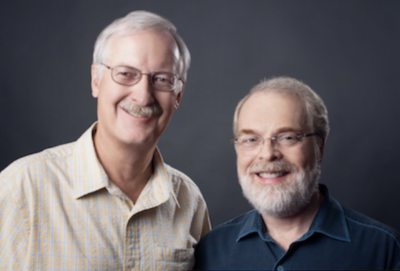 On Saturday, July 28th, the Walt Disney Family Museum in San Francisco’s historic Presidio played host to a special presentation. To celebrate their latest special exhibit, which focuses on Walt Disney’s infamous Nine Old Men, two legendary figures of modern Disney animation took the stage to share their memories of working with the men who trained the generation of artists responsible for the second golden age. The films directed by Ron Musker and John Clements include The Little Mermaid, Aladdin, Hercules, Treasure Planet, The Princess and the Frog, and Moana.
On Saturday, July 28th, the Walt Disney Family Museum in San Francisco’s historic Presidio played host to a special presentation. To celebrate their latest special exhibit, which focuses on Walt Disney’s infamous Nine Old Men, two legendary figures of modern Disney animation took the stage to share their memories of working with the men who trained the generation of artists responsible for the second golden age. The films directed by Ron Musker and John Clements include The Little Mermaid, Aladdin, Hercules, Treasure Planet, The Princess and the Frog, and Moana.
Like all of us, Ron and John were first introduced to the Nine Old Men as kids watching the animated classics they created. They learned more about the individuals in their teen years as each perused a career in the animated arts. Ron Clements met Eric Larson on his first visit to the studio at the age of twenty when he brought in his portfolio. He soon found himself under the mentorship of Frank Thomas working on Winnie the Pooh and Tigger, Too.
John Musker’s first encounter with one of the Nine Old Men came at CalArts, where he was a student during the first year of the Character Animation Program among peers that included John Lassiter and Brad Bird. One of his teachers was John Lounsbery while Woolie Reitherman, Marc Davis, Frank Thomas, and Ollie Johnson served on the review board to critique their work.
They talked about each of the Nine Old Men, whether they worked with them or not, and showcased examples of some of their finest work. What follows is a summary of the information they shared on each.
Eric Larson

Photo Source:
Eric Larson was known as the "Godfather" to many animators in his role as the head of the Studio Talent Department. In 1976, John Musker found himself interning at Disney for Eric Larson. One of his tests was so poorly received that the studio almost let him go, but Larson fought to give him one last chance and saved his job. John described him as a "Quiet Mormon man." In his mentorship role, he would often draw over his student's work and emphasized changing shapes from convex to concave. He was also a wealth of knowledge on past animation and where to find it in the morgue. John remembers Larson providing some Ward Kimball drawings from an obscure war short on Hitler when John was working on an animation test for a heavy character. Eric Larson was most famous for animating Figaro in Pinocchio, Cinderella, and Peg in Lady and the Tramp.
Les Clark
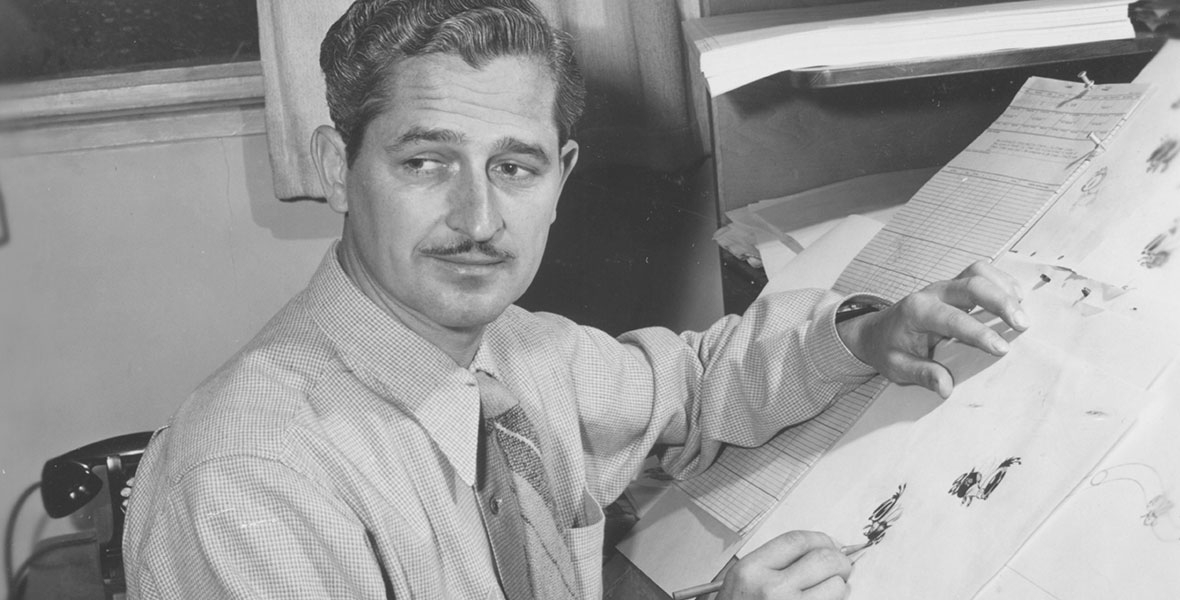
Photo Source:
Ron and John never got to work with Les Clark, as he retired from animation before either arrived at Disney. He was most famous for his animation of Mickey Mouse during the shorts era, but also animated Lady as a puppy. John Musker recalled being at the Annie Awards when Les Clark was honored with a posthumous award. He was at the same table as Les’ widowed wife and when they showed an image of Walt Disney with a closeup of his hands drawing Mickey, she said “Those are Les’ hands!”
John Lounsbery
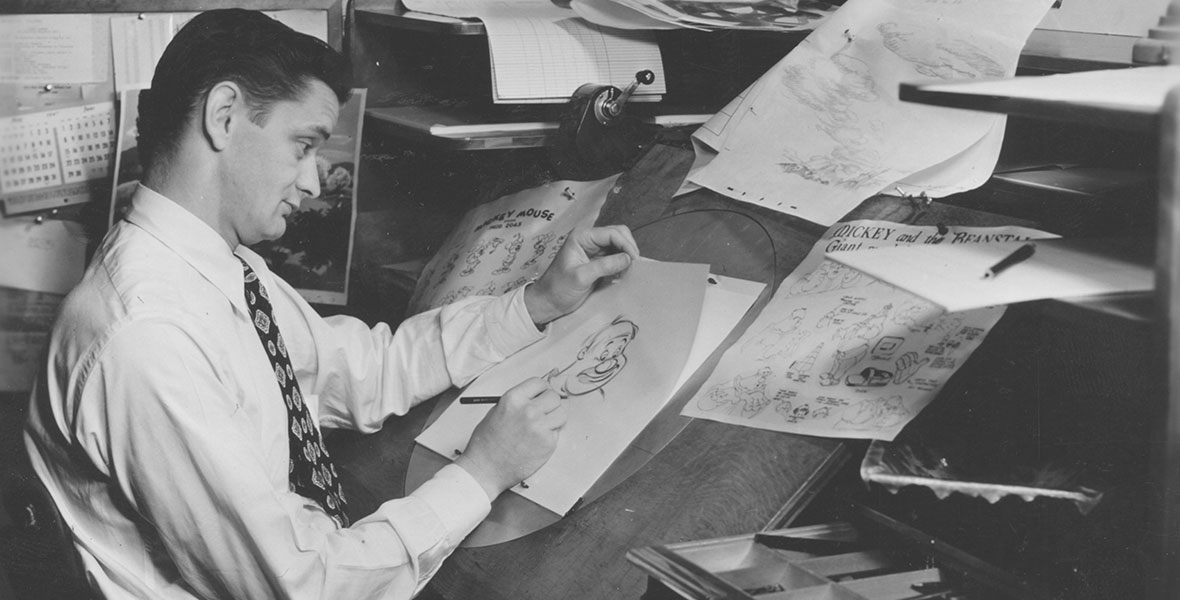
Photo Source:
Ron Musker worked with John Lounsbery when he was cutting his teeth at the studio on Winnie the Pooh and Tigger, Too. During production on The Rescuers, which was co-directed by Lounsbery, Ron spent time with him reviewing a scene he had animated, which Lounsbery complimented. He then talked about his upcoming weekend skiing trip, an excursion Lounsbery didn’t return from. During the trip, he had chest pains and passed away under a doctor's care from a heart attack. He was the youngest of the Nine Old Men, but the first to pass away. Ron recalls how it really shook the studio and was the first sign that a generation was coming to an end. Ron Musker and John Clements were inspired by Lounsbery’s animation style in the design of The Princess and the Frog. Lounsbery’s animation highlights include Ben Ali Gator in Fantasia, Timothy Mouse in Dumbo, and Tony and Joe in Lady and the Tramp.
Ward Kimball
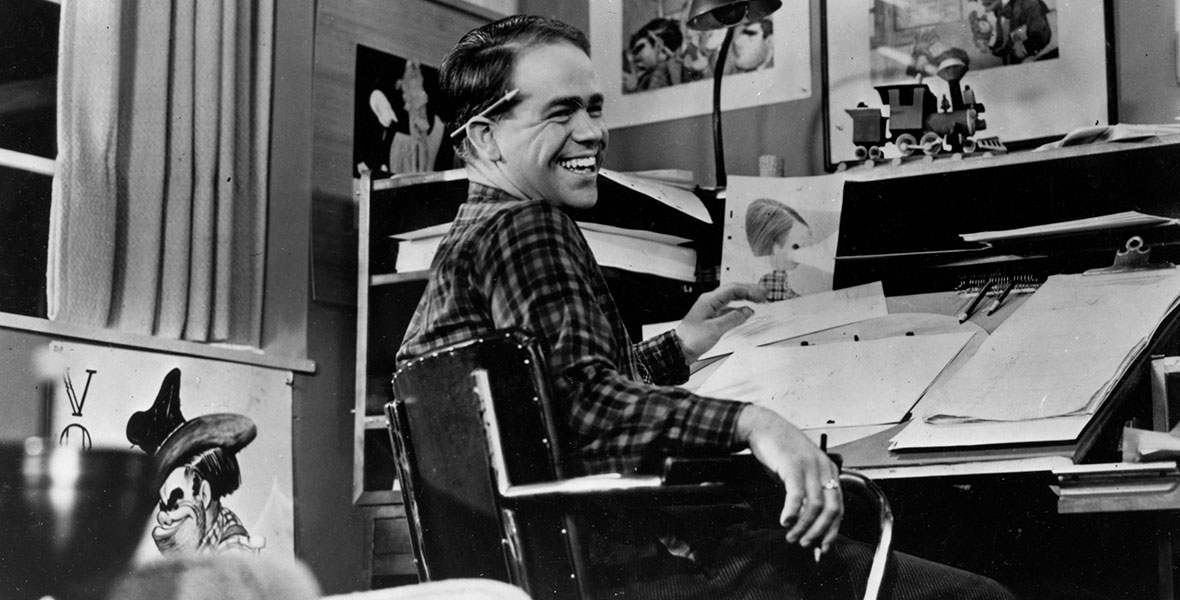
Photo Source:
The most eccentric of the Nine Old Men, Ward Kimball lead evening classes and lectures that Ron and John both attended. Ron recalls him saying to a class one evening, “Walt’s dead and you missed it!” Frank Thomas remembers that some of the Nine Old Men were resentful towards Ward because Walt Disney once characterized him as a genius, and Walt rarely shelled out compliments to his animators. When John Musker was a Co-Director on The Black Cauldron, he and his fellow directors paid Ward a visit to ask his advice on their difficult project. His advice was to find something in the story that they believe in. Ward’s most famous animation contributions include Jiminy Cricket in Pinocchio, Cheshire Cat and Mad Hatter in Alice in Wonderland, and Lucifer in Cinderella.
Woolie Reitherman
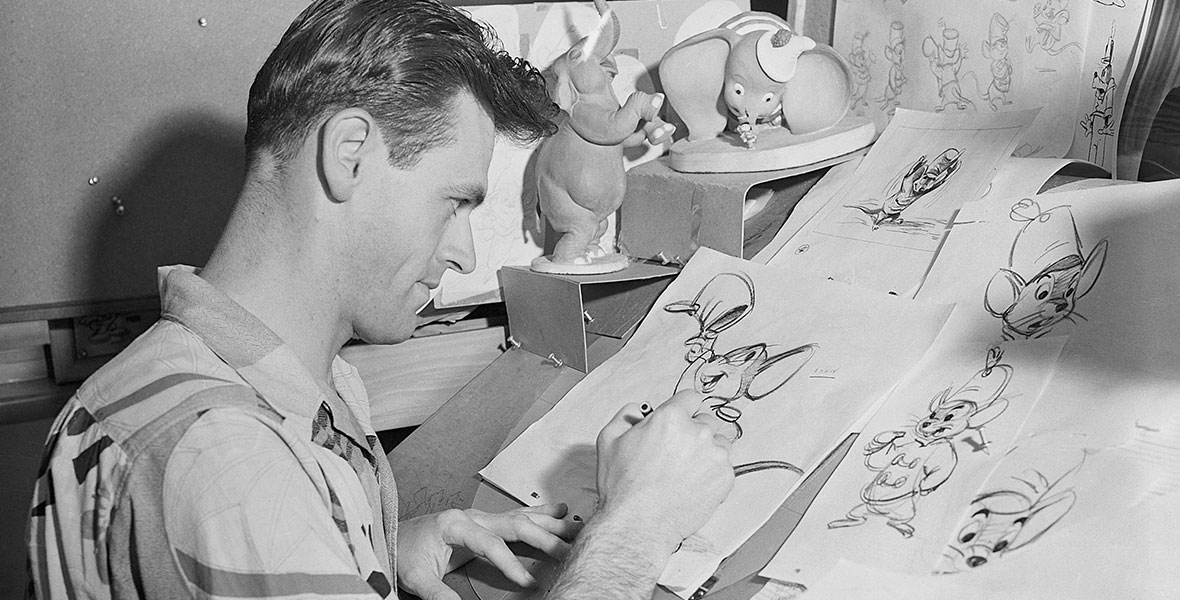
Photo Source:
John Musker described Woolie Reitherman as a “Craggy man’s man.” He originally wanted to be a water colorist, but found his specialty in action sequences and quickly rose through the ranks as the first solo Director of a Disney animated feature on all films from The Sword in the Stone (1963) through Robin Hood (1973). In addition to his directorial success, Woolie is remembered for his animation of the T-Rex battle from Fantasia, Captain Hook in Peter Pan, and the Headless Horseman in The Adventures of Ichabod and Mr. Toad.
Milt Kahl
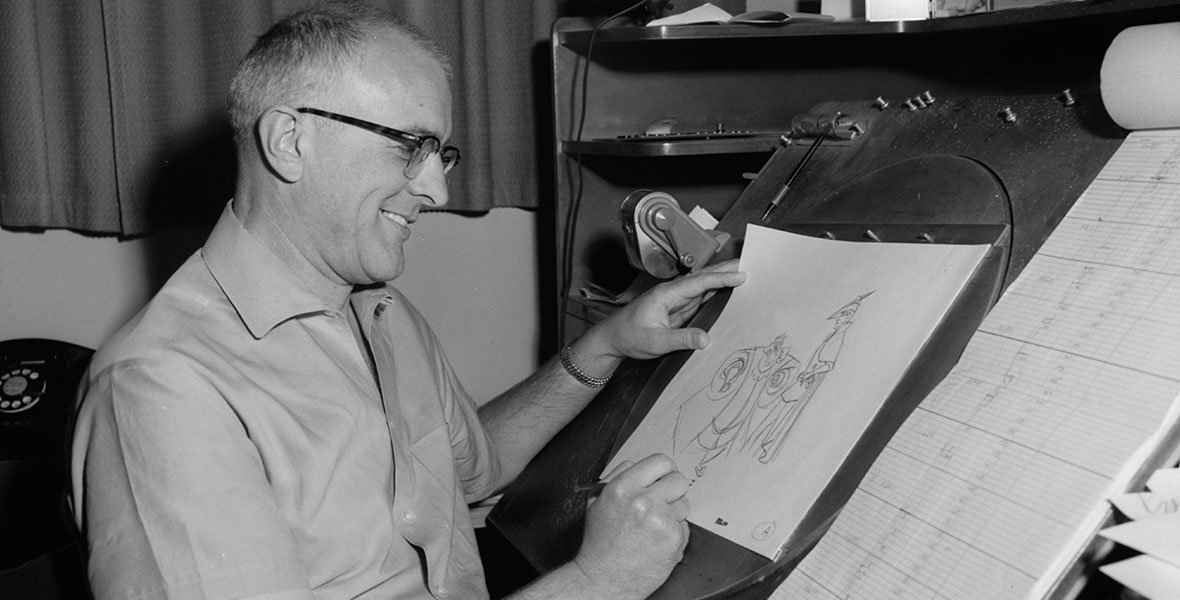
Photo Source:
Ron and John worked alongside Milt Kahl, who left the studio after The Rescuers. He was known for being very critical and challenging and was the only working member of the Nine Old men who didn’t mentor the next generation of artists at Disney. In awe of his talent and desperate to learn from him, animators would dig through his trash to study his rejected drawings, which is how many of them ended up in the hands of private collectors. He was resentful for having been forced to work on refined characters most of his career and they recall him still complaining about not getting to work on Captain Hook over two decades later. However, he got his wish on his final project by animating Madam Medusa. He is best known for animating Pinocchio, Thumper in Bambi, Wendy in Peter Pan, Alice in Alice in Wonderland, Prince Phillip in Sleeping Beauty, Pongo in 101 Dalmatians, and Shere Khan in The Jungle Book.
Marc Davis
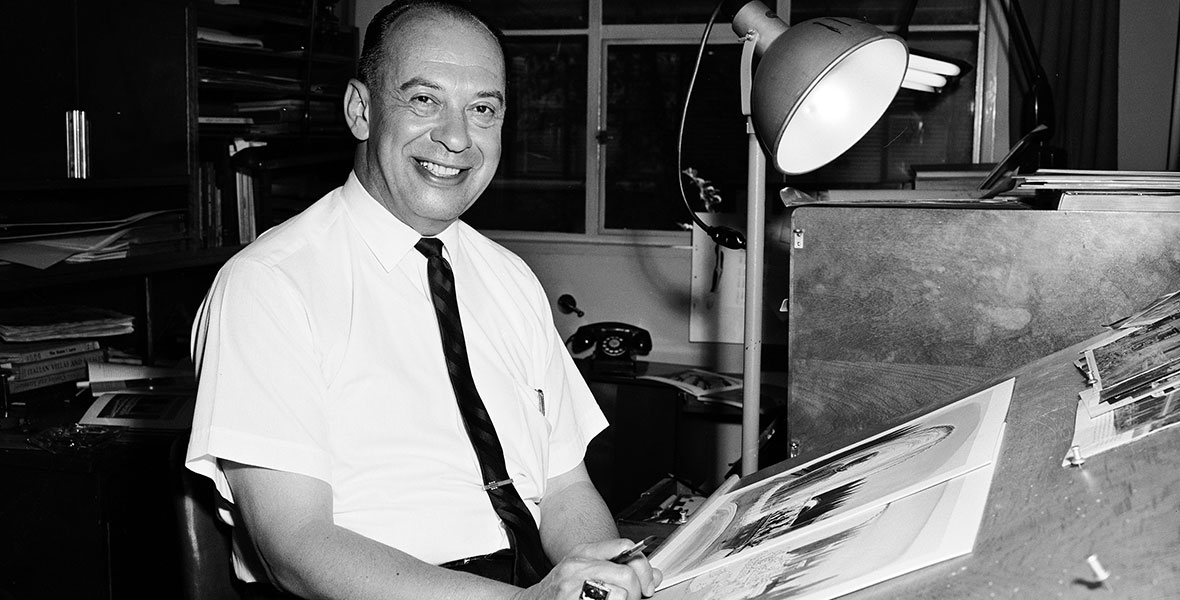
Photo Source:
John Musker remembers the other Nine Old Men being resentful of Marc Davis, downplaying his work due to the fact that he preferred to use live action reference footage for his characters. Ron and John have compared the footage to his animation, which showcases the brilliance of his animation and reveal that the footage was merely a helpful resource and not for rotoscoping. His career took him away from animation and into Imagineering during the time that Ron and John worked at the studio. He is most famous for animating Bambi, Tinker Bell in Peter Pan, Melficent in Sleeping Beauty, and Cruela De Vil in 101 Dalmatians.
Ollie Johnston
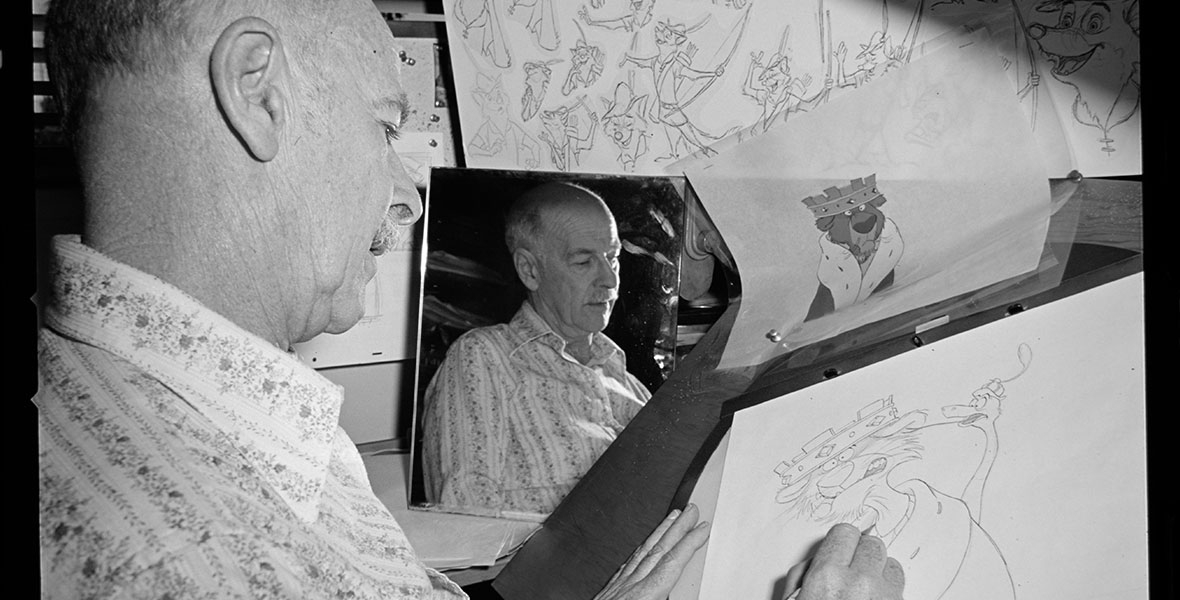
Photo Source:
Ron Clements first met Ollie Johnston in the halls of the old Animation building. Ron was talking with a man who was replacing soda cans in the vending machine and assumed that was the gentleman’s job, but soon realized he was talking to the co-author of the first animation book he ever read. He describes Ollie as being “Very low key and quiet.” Ollie was the fastest animator of the Nine Old men and made it look easy, often ending up with the highest volume of footage per film. The Rescuers, for example, has over 12-minutes of animation done by Ollie Johnston. Ron recounted an example of Ollie’s famously calm demeanor when an in-betweener took home the final scene of The Rescuers, which was not easy animation, and accidentally left the scene on the top of her car when she drove away. The pages ended up all over Burbank and Ollie had to redo the work, but told her it was okay and never showed his frustration. He was famous for animating Alice in Alice in Wonderland, Trusty in Lady and the Tramp, Smee in Peter Pan, and Prince John in Robin Hood.
Frank Thomas
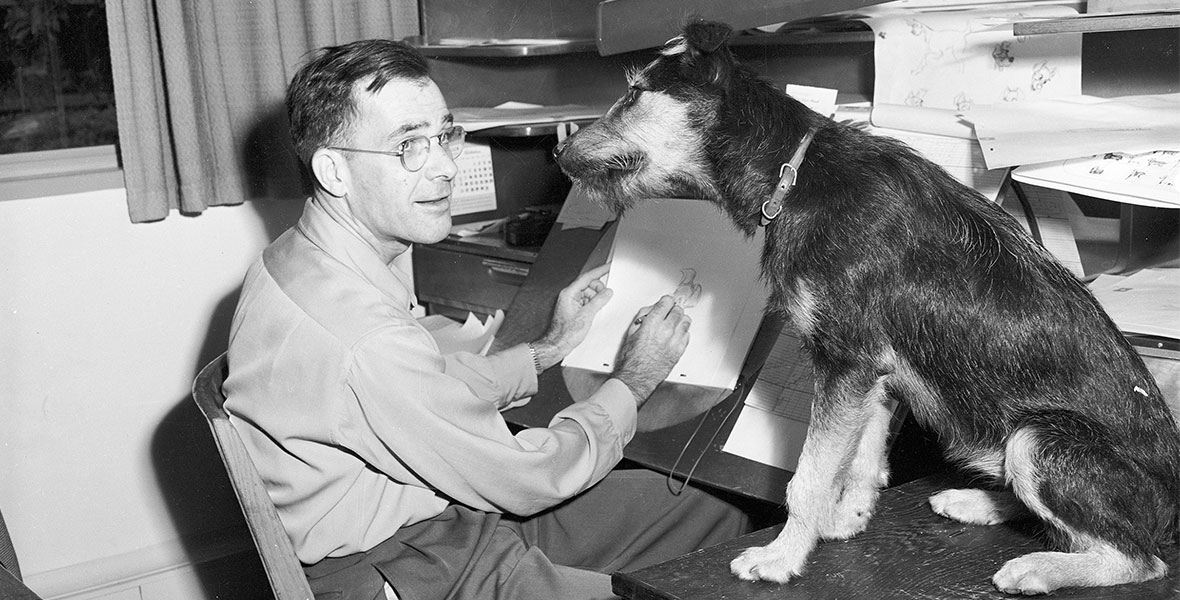
Photo Source:
Chuck Jones referred to Frank Thomas as “The Laurence Olivier of animated acting.” He was responsible for the scene in Snow White where the dwarves grieve, bringing the audience to tears. The infamous spaghetti sequence in Lady and the Tramp was his idea, but Walt didn’t think it would work. Frank fought hard for Walt’s approval to rough out the scene and after showing it to the boss, Walt couldn't deny its charms. Around the studio, Frank was known as the “Velvet needle,” capable of saying cutting things but in a gentle way. Frank only worked with a blue pencil and was a perfectionist. According to Ron and John, one of the few pieces of work he was happy with was a sequence at the end of The Rescuers where Bernard and Bianca float down on a parachute. He was also famous for animating Mickey Mouse in The Brave Little Tailor, Captain Hook in Peter Pan, and Baloo in The Jungle Book.
During a Q&A at the end of the panel, a guest asked about the influence of the Nine Old Men on modern animation. Ron shared that in terms of watching for the transition, Robin Hood was the last animated feature primarily animated by Walt’s generation of animators. The Rescuers was about half of Walt’s men and half of the new generation learning from them. And The Fox and the Hound was mostly animated by this new generation now that they had their footing. But the influence of the Nine Old Men can certainly be felt in recent productions and he credits Tangled with applying the foundations established by the Nine Old Men to the CG world.
Disney fans can visit the Walt Disney Family Museum in San Francisco. The official website has details on hours, upcoming events, and limited galleries that can help you plan your trip.


